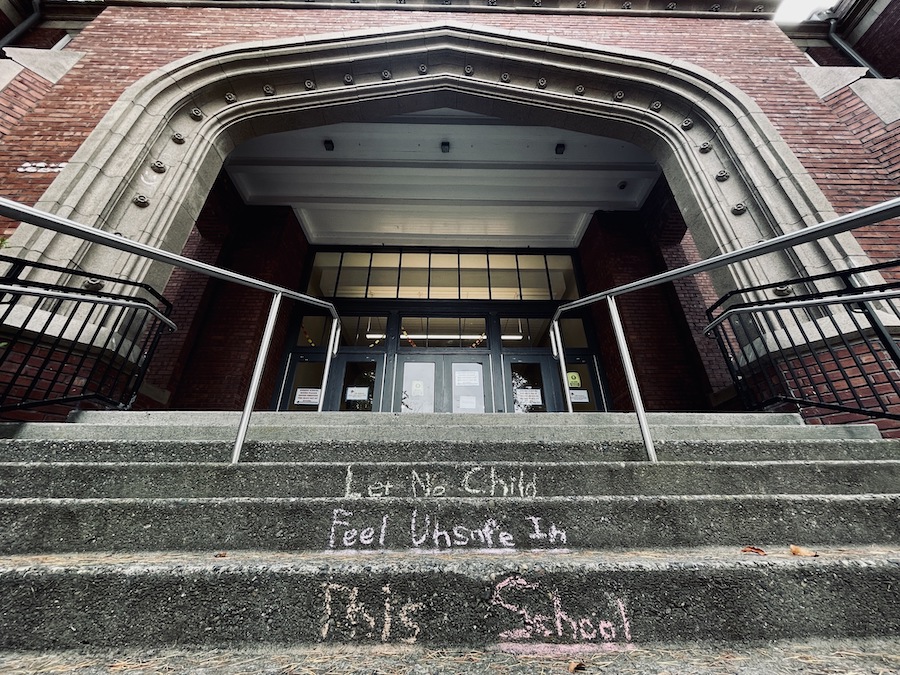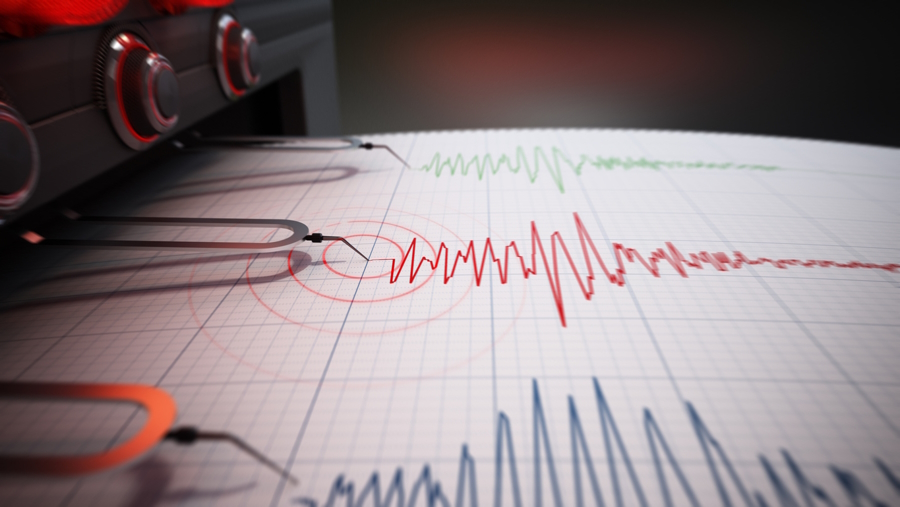
Photo:
Lincoln High School in Seattle's Wallingford neighborhood, Oct. 11, 2024. LHS is part of Seattle Public Schools. Photo: Kristin Leong
Hundreds of public schools across Washington are located in areas where they could suffer damage in a major earthquake. But more than a decade after the state set out to evaluate school seismic risks, the information is difficult to access and harder to verify.
In the last school year, more than 378,000 students attended school in buildings constructed before the adoption of modern seismic codes and that have no risk evaluations or retrofits, according to data from the Washington Office of Superintendent of Public Instruction obtained through a public records request. The majority of seismic risk data collected by school districts and the state is not shared with the public.
An additional 167,000 students attended schools already assessed as having “high” or “very high” seismic risks, based on their locations and building conditions.
Compiling the school seismic data is aimed at determining the scope of vulnerabilities across the state to prioritize building improvements and to inform emergency planning.

Other states are further ahead. California, Oregon and Utah published school seismic inventories in 2002, 2007 and 2022, respectively. The Washington Legislature has favored a more incremental approach that Gov. Jay Inslee said could take decades to complete.
“Slowly we get more money and slowly we get more information,” said Scott Black, program development manager at the Office of Superintendent of Public Instruction, which is overseeing the data project.
Multiple school districts provided records of seismic evaluations and upgrades they’ve made to their buildings that have not been recorded as retrofits in the state data. Asked why the database does not recognize their upgrades as retrofits, some districts said they were viewing a different version of the data.
Meanwhile, district-level reports show estimates for how badly school buildings could be damaged in a quake and hazard information missing from the statewide data.
“Number one, you can’t see all the information, and number two, all the information may not even be in there. And that should be required,” said DaleAnn Baker, a parent and engineer who helped the Stanwood–Camano School District work on a hazard mitigation plan.
Black attributed inconsistent and missing data to districts not updating their records. But an analysis showed 160 building evaluations from the $3.4 million School Seismic Safety Project are also missing from the database, despite a legislative requirement for the agency to upload those results. “This is likely a mistake in the data that needs correction,” Black responded.
Quake risks
Washington has dozens of active fault lines including the region’s largest active fault — the Cascadia subduction zone. A major quake in the subduction zone could cause “moderate or complete” damage to about 2,000 Washington schools, according to a 2022 report from the Federal Emergency Management Agency.
But the state agencies that lead school seismic assessments use different methods for determining hazard levels at school campuses. The Department of Natural Resources estimates that 70 percent of K–12 schools in Washington are located in high seismic risk areas, based on national hazard models.
“The hazard is the likelihood and severity of ground motion at a site: how hard the ground shakes and how often that happens,” said Alex Steely, the department’s assistant director of Geologic Hazards and Mapping.
The Office of Superintendent of Public Instruction categorizes only 28 percent of the state’s roughly 2,025 schools as having high seismic hazards. The office reduces the threat level for campuses that are likely to have stronger soil types. Black said this approach to determining hazard levels is “not very common.”

Despite these risks, there is no state law requiring school districts to conduct seismic evaluations. And due to the secrecy of the data that does exist, school communities may be unaware of risks that are already recorded.
Conducting structural evaluations of Washington schools to assess earthquake safety has been a long-running state goal. However, timelines for completion, set by a state task force and the Emergency Management Division, have passed, with evaluations completed for less than half of older schools. A 2019 legislative proposal for mandatory evaluations did not move forward.
Cale Ash, a member of a seismic safety advisory committee to the Office of Superintendent of Public Instruction, said public visibility into the database would benefit families. “Let’s say one of your children is about to go to a new school. Well, you would have a chance to look at and actually have some information around the earthquake safety of that school,” Ash said.
Greater public access to seismic risk data can also help to spur building upgrades, according to Brian Terbush, earthquake and volcano program coordinator at Washington’s Emergency Management Division.
“While it sounds scary to know that your building is dangerous in an earthquake, in a lot of ways that’s one of the important ways to actually get the community to help apply for these grants to fund [retrofits],” Terbush said.
Plans are underway to incorporate the school data into a state inventory of unreinforced masonry buildings, which are known for dropping bricks onto neighboring buildings and streets during earthquakes. “Having a sense of where these buildings might be is really important for emergency response. It helps us plan ahead,” said Terbush.
But first the state will have to find these dangerous buildings. The schools database could not be incorporated into a prior such inventory due to lack of construction type information, which is still missing for hundreds of older buildings statewide, and shows inconsistent information for Seattle Public Schools compared to the district’s list of unreinforced masonry buildings.
Randy Newman, school facilities director at the Office of Superintendent of Public Instruction, said “maybe” data will be shared once more information is collected.
Tracking seismic upgrades
After the 2001 Nisqually earthquake struck the Puget Sound region, the Edmonds School District set out to better protect vulnerable schools. Over the next nine years, the district completed seismic retrofits at 18 schools. But according to the state data, the district has no retrofits.
Crystal Springs Elementary in Bothell received a seismic upgrade after a 2010 evaluation called for anchoring the walls to the roof, adding nails to plywood walls and bracing storage racks and file cabinets, according to documents from the Northshore School District. The school, built in 1956, is now undergoing an expansion, but has no evaluations or retrofits in the state data.
The Department of Natural Resources called for a survey of school districts to collect information on past seismic upgrades for the database, starting with large, well-funded districts. But five years later, the survey was never done.
Some districts provide seismic data to the state through a voluntary grant program tied to building condition assessments that are required to apply for construction funds. But the retrofit field is not required, and not all districts complete the assessments.
“A lot of them don’t really want to do that if they’re not getting funding,” Black said.
The Edmonds, Bellevue, Northshore and Bellingham school districts are among 163 districts and state-tribal education compact schools with no seismic evaluations or retrofits in the state data, although all four districts provided retrofit records for this story.
Omitting retrofits from the state data can lead to higher risk ratings for schools, as the state estimates that many high risk buildings would be deemed low risk with a retrofit.
Jeff Rogers, Director of Environmental Health and Safety for Tacoma Public Schools, said districts will often appoint someone to update their records following construction projects, “But a lot of times it doesn’t happen because a project manager has never been told, ‘hey when you’re done with your upgrading, you need to provide this information to [the Office of Superintendent of Public Instruction].’”

Missing information is also due to variable interpretations about what qualifies as a retrofit.
Tina Christiansen, a spokesperson for Seattle Public Schools, said upgrades may not be marked as retrofits when they are part of full renovations or affect only portions of a building. “There is not a partial retrofit or upgrade option,” said Christiansen, adding that the district couldn’t verify how the upgrades were categorized in the state database.
The School Seismic Safety Project, which evaluated one in eight school buildings, did not make these distinctions. “Within the reports, the terms ‘seismic upgrades,’ ‘retrofits’ and ‘structural upgrades’ are used interchangeably and generally mean the same thing,” said Loyd Travis West, a geophysicist at the Department of Natural Resources. But more than 50 seismic and structural upgrades recorded in project reports are not listed as retrofits in the state data.
Seattle Public Schools updated its list of seismic improvements to distinguish between building renovations and replacements in response to questions for this story, but continues to list additional retrofits that were not found in the state data.
Seismic upgrades totaling $16 million in the Bellingham School District are also missing from the data, despite the district’s assertion that the projects were added.
Taine Wilton, director of capital projects for the Edmonds School District, noted that building condition assessments, which the district completes, “are not about checking if the buildings meet code requirements or testing how they would withstand extreme forces including wind, rain, seismic, or fire.”
Seismic safety experts say that comprehensive evaluations of buildings and ground conditions are the best way to identify vulnerable schools, compared with satellite imagery or construction drawings alone, as schools often have multiple wings constructed in different years.
“The safety of buildings is highly dependent on structural materials, so I think that on-site work is very valuable,” said Ash.
Steely echoed the call for evaluations, saying, “The more fully we know which structures are built to withstand ground shaking, and the site conditions at that school that either increase or decrease the shaking, the better we as a state can plan for upgrades and mitigation measures.”
Editor’s note: This article is republished from Washington State Standard under a Creative Commons license.











